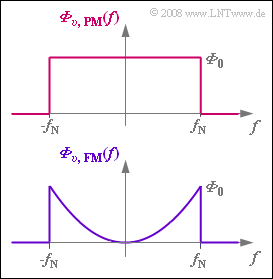Exercise 3.10: Noise Power Calculation
Consider the phase and frequency modulation of a cosine oscillation with frequency $f_{\rm N}$. . First, let the message frequency be $f_{\rm N} = f_5 = 5 \ \rm kHz$ and the modulation index (phase deviation) be $η = 5$.
In the presence of additive Gaussian noise with noise power density $N_0$ , the PM demodulator results in a constant noise power density ${\it \Phi}_{v {\rm , \hspace{0.08cm}PM} }(f) = {\it \Phi}_0$, which also depends on the modulation index $η$ :
- $${\it \Phi}_0 = \frac{N_0}{\eta^2} \hspace{0.05cm}.$$
For the calculation of the noise power $P_{\rm R}$ , only the frequency range $±f_{\rm N}$ is relevant (see graph).
The noise power density after FM demodulation with the frequency deviation $Δf_{\rm A}$ is:
- $${\it \Phi}_{v {\rm , \hspace{0.08cm}FM} } (f) = N_0 \cdot \left(\frac{f}{\Delta f_{\rm A}}\right)^2 \hspace{0.05cm}.$$
- The signal-to-noise ratio $10 · \lg ρ_v = 50 \ \rm dB$ is given for phase modulation with $f_{\rm N} = 5 \ \rm kHz$.
- In this task, we are looking for the S/N ratio of FM for the message frequency $f_{\rm N} = 5 \ \rm kHz$ as well as the resulting S/N ratios of PM and FM for message frequency $f_{\rm N} = f_{10} = 10 \ \rm kHz$.
Hints:
- Die Aufgabe gehört zum Kapitel Rauscheinfluss bei Winkelmodulation.
- Bezug genommen wird insbesondere auf den Abschnitt Systemvergleich von AM, PM und FM hinsichtlich Rauschen.
Fragebogen
Musterlösung
- $$ \rho_{v } = \frac{P_{\rm S}}{P_{\rm R}} = \frac{P_{\rm S}}{{\it \Phi}_0 \cdot 2 f_{\rm N} } =\frac{\eta^2}{2} \cdot \frac{P_{\rm S}}{N_0 \cdot f_{\rm N} }\hspace{0.05cm}.$$
- Die Messung mit $f_{\rm N} = f_5 = 5 \ \rm kHz$ hat das SNR $ \rho_{v } = 10^5$ $($entsprechend $10 · \lg ρ_v =50\ \rm dB)$ ergeben.
- Die doppelte Nachrichtenfrequenz führt zum halben SNR, da nun die doppelte Rauschleistung wirksam ist:
- $$ \rho_{v }= 0.5 \cdot 10^5 \hspace{0.3cm}\Rightarrow \hspace{0.3cm} 10 \cdot {\rm lg} \hspace{0.15cm}\rho_{v } \hspace{0.15cm}\underline {\approx 46.99\,{\rm dB}}\hspace{0.05cm}.$$
Dieses Ergebnis lässt sich auch über die Beziehung $ρ_v = η^2/2 · ξ$ herleiten.
- Bei Phasenmodulation ist $η$ unabhängig von der Nachrichtenfrequenz.
- Der SNR–Verlust geht darauf zurück, dass nun die Leistungskenngröße $ξ = P_{\rm S}/(N_0 · f_{\rm N})$ halbiert wird.
(2) Bei Frequenzmodulation und der Nachrichtenfrequenz $f_{\rm N} = 5 \ \rm kHz$ erhält man für die Rauschleistung:
- $$P_{\rm R} = \int_{-f_{\rm N}}^{ + f_{\rm N}} {\it \Phi}_{v {\rm , \hspace{0.08cm}FM} } (f)\hspace{0.1cm}{\rm d}f = \frac{2 \cdot N_0}{\Delta f_{\rm A}^{\hspace{0.1cm}2}} \cdot \int_{0}^{ f_{\rm N}} f^2\hspace{0.1cm}{\rm d}f = \frac{2 \cdot N_0 \cdot f_{\rm N}^{\hspace{0.1cm}3}}{3 \cdot \Delta f_{\rm A}^2} \hspace{0.05cm}.$$
- Unter Berücksichtigung des Frequenzhubs $Δf_{\rm A} = η · f_{\rm N}$ ergibt sich somit:
- $$P_{\rm R} = \frac{2 \cdot N_0 \cdot f_{\rm N}}{3 \cdot \eta^2} \hspace{0.3cm}\Rightarrow \hspace{0.3cm} \rho_{v }= \frac{3 \cdot \eta^2 \cdot P_{\rm S}}{2 \cdot N_0 \cdot f_{\rm N}} = 3 \cdot \rho_{v {\rm , \hspace{0.08cm}PM}}\hspace{0.05cm}.$$
- Das heißt: Die Frequenzmodulation ist um den Faktor $3$ $($oder $4.77 \ \rm dB)$ besser als die Phasenmodulation:
- $$10 \cdot {\rm lg} \hspace{0.15cm}\rho_{v }= 50\,{\rm dB} + 10 \cdot {\rm lg} \hspace{0.15cm}{3}\hspace{0.15cm}\underline {\approx 54.77\,{\rm dB}}\hspace{0.05cm}.$$
(3) Entsprechend dem Ergebnis der Teilaufgabe (2) erhält man mit $f_{10} = 10 \ \rm kHz$:
- $$P_{\rm R} = \frac{2 \cdot N_0 \cdot f_{\rm 10}}{3 \cdot \eta_{10}^{\hspace{0.1cm}2}} = \frac{ f_{\rm 10} \cdot \eta_{5}^{\hspace{0.1cm}2}}{ 3 \cdot f_{\rm 5} \cdot \eta_{10}^{\hspace{0.1cm}2}}\cdot \frac{2 \cdot N_0 \cdot f_{\rm 5}}{\eta_{5}^{\hspace{0.1cm}2}} \hspace{0.05cm}.$$
- Der zweite Term gibt die Rauschleistung des Vergleichssystems $($PM, $f_{\rm N} = f_5)$ an, die zum Ergebnis $10 · \lg ρ_v = 50\ \rm dB$ geführt hat.
- Bei Frequenzmodulation ist nun jedoch der Modulationsindex $η$ umgekehrt proportional zur Nachrichtenfrequenz, so dass der Quotient $η_5^2/η_{10}^2 = 4$ ist.
- Somit ergibt sich für den Vorfaktor $8/3$. Aufgrund der größeren Rauschleistung ist das SNR kleiner:
- $$10 \cdot {\rm lg} \hspace{0.15cm}\rho_{v }= 50\,{\rm dB} - 10 \cdot {\rm lg} \hspace{0.15cm}({8}/{3})\hspace{0.15cm}\underline {\approx 45.74\,{\rm dB}}\hspace{0.05cm}.$$
Bei gleicher Nachrichtenfrequenz $f_{\rm N} = 10 \ \rm kHz$ ist nun die FM um $1.25 \ \rm dB$ schlechter als die PM, da sich nun die Halbierung von $η$ – nach Quadrierung der Faktor $4$ – stärker auswirkt als der systembedingte Faktor $3$, um den die FM gegenüber der PM überlegen ist.
- Der Vergleich der Teilaufgaben (2) und (3) zeigt einen Unterschied um den Faktor $8$ bzw. $9.03 \ \rm dB$.
- Der ungünstigere Wert für die größere Nachrichtenfrequenz $f_{\rm N} = 10 \ \rm kHz$ ergibt sich durch den nur halb so großen Modulationsindex – nach Quadrierung Faktor $4$ – und die doppelte Rauschbandbreite.
